The Residential Area in the early 20th Century: The Age of George Eastman
George Eastman moves inIn 1905, George Eastman, the founder of the Eastman Kodak Company, built his mansion at 900 East Avenue. It was to be the largest house in the city. Eastman hired local architect J. Foster Warner, working with the New York firm McKim, Mead & White, and supervised the construction closely. After its completion, the Georgian-style house, complete with its own pipe organ, became perhaps the main social center of the entire community. Famous visitors, lavish parties and the active participation of Eastman in the affairs of the city brought a new flavor to the area. George Eastman remained in this house until his death from suicide in 1932.
One of the most interesting facts about the George Eastman House is that after it was built, Mr. Eastman decided that the middle of the house needed to be larger. According to the George Eastman House web site (www.eastman.org).
"In 1919 the house was expanded and the Conservatory was enlarged. This was done by cutting the house in half and moving the back portion 9'4" away from the front. This renovation cost Eastman $750,000, more than the initial cost of building the house. " |
The George Eastman House, as seen today in its incarnation
home to the Museum of Photography and Film.
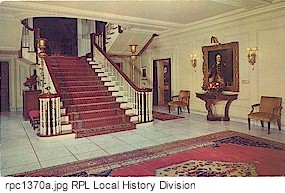 |
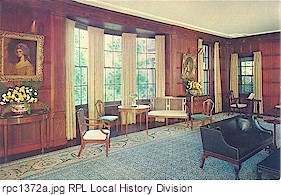 |
Left, the main staircase in the Eastman House; Right, the main room of the Eastman House
The library, George Eastman House
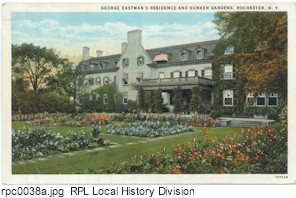 |
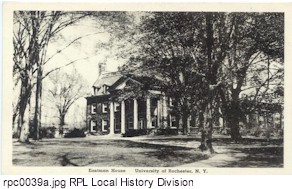 |
Left, a side view of the Eastman House, showing some of the gardens; Right, the Eastman House after Eastman's death, when it was willed to the University of Rochester to be used as the President's residence
The historian Blake McKelvey referred to the neighborhood as an "Avenue of Presidents" and with good reason. The Rochester House Directory and the City Directory for the years 1903-1904 show that the city's elite, many company presidents among them, lived on East Avenue.
Changes began to take place in the early 20th century. Horse races turned into races between horse and automobile, then between automobile and automobile. The avenue needed to be resurfaced to accommodate the new mode of transportation. George Eastman was on the committee to recommend pavement for the avenue. The business district portion of the street was widened.
Once the home of nurseries, flowers still bloomed along the avenue in the form of elaborate private gardens. However, some of the famous elm trees became victims of the elm tree beetle.
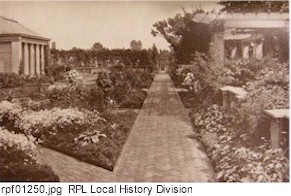 |
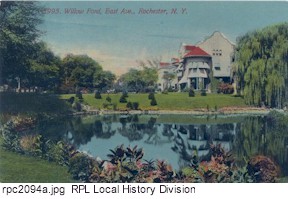 |
Left, part of George Eastman's garden; Right, one of the most elaborate gardens was at the Brown estate at Willow Pond.
Send comments to Webmaster
Copyright
Monroe County (NY) Library System
115 South Ave., Rochester, NY 14604